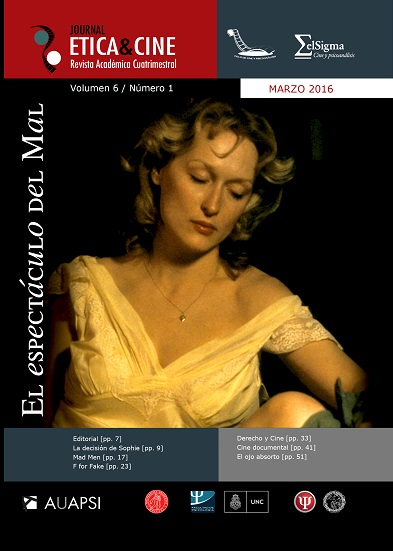The ethics of representation in documentary film
DOI:
https://doi.org/10.31056/2250.5415.v6.n1.14860Keywords:
Documentary film, Characters, EthicsAbstract
Unlike fiction films, documentary refers to reality with the intention of “expressing truth”, which is why filmmakers have an obligation to both viewers (that represented facts are true) and to the subjects / characters. However, these obligations are not explicitly outlined, as the documentary treats reality in a creative way, which forces us to talk about ethics, understood as codesof human behavior. These codes are not unchangeable, but vary from society to society and from age to age, but a constant is the inequality of power between the subjects and the filmmakers. This article proposes to investigate a number of specific axes such as the necessary conditions to consider a given consent as valid, the strategies adopted to conducting interviews and the representation of death from the analysis of three recent Argentine documentary: Yo no sé qué me han hecho tus ojos (2003, Sergio Wolf & Lorena Muñoz), Yo presidente (2006, Gastón Duprat & Mariano Cohn) and Bye bye life (2008, Enrique Piñeyro).Downloads
References
Alonso, M. (2003). “Distancias”, en Kilómetro 111, n°5. Buenos Aires: Santiago Arcos Editor, pp. 176-181.
Aufederheird, P., Jaszi, P., y Chandra, M. (2009). Honest Truths: Documentary Filmmakers on Ethical Challenges in Their Work. Washington: Center for Social Media. Disponible en: http://centerforsocialmedia.org/making-your-media-matter/documents/best-practices/honest-truths-documentary-filmmakers-ethical-chall
Barnouw, E. (1996). El documental. Historia y estilo. Barcelona: Gedisa editorial.
Bazin, A. (2004). “Ontología de la imagen fotográfica”, en ¿Qué es el cine? Madrid: Ediciones RIALP, pp. 23-32.
Colleyn, J. (1993). Le regard documentaire. Paris: Editions du centre Pompidou.
Comolli, J.L. (1997). “¿Cómo filmar al enemigo?”, en Ver y poder. Buenos Aires: Nueva Librería, pp. 371-383.
Comolli, J.L. (1994). “La otra escucha... Práctica y teoría de la entrevista”, en Ver y poder. Buenos Aires: Nueva Librería, pp. 177-180.
Coutinho, E., Xavier, I., y Furtado, J. (2011). “El sujeto (extra)ordinario”, en El cine de lo real. Buenos Aires: Colihue, pp. 77-115.
Crowder-Taraborrelli, T. (2012). “Verdades honestas: la ética en el cine documental”, enRevista Cine Documental n° 5. Buenos Aires. Disponible en: http://revista.cinedocumental.com.ar/5/teoria_02.html
Kieslowski, K. (1993). “The Unique Role of Documentaries”, en Cousins, M. y McDonald, K. (eds.): 2006. Imagining Reality. The Faber Book of Documentary. Londres: Faber & Faber, pp. 312-316
Krippner, J. (2010). Paul Strand in Mexico. New York: Aperture Fundation.
Hampe, B. (1997). Making documentary films and reality videos. A Practical Guide to Planning, Filming, and Editing Documentaries of Real Events. New York: Henry Holt and Company, Inc.
Kalow, N. (2011). Visual Storytelling. The Digital Video Documentary. North Carolina: CDS Publication. Disponible en http://documentarystudies.duke.edu/uploads/media_items/visual-storytelling-the-digital-video-documentary.original.pdf
Mendoza, C. (2008). La invención de la verdad: nueve ensayos sobre cine documental. México: Universidad Nacional Autónoma deMéxico.
Nichols, B. (2007). “Cuestiones de ética y cine documental”, en Archivos de la Filmotecan°57, Valencia: Ediciones de la Filmoteca, pp.27-45.
Nichols, B. (1997). La representación de la realidad. Cuestiones y conceptos sobre el documental. Barcelona: Paidós.
Niney, F. (2009). La prueba de lo real en la pantalla. Ensayo sobre el principio de realidad documental. México: Universidad Nacional Autónoma de México, Centro Universitario de Estudios Cinematográficos.
Noriega, G. y Panozzo, M. (2006). “Traicionamos el género documental”. Revista El Amante. Octubre, N° 173.
Pena de Oliveira, F. (2009). Teoría del periodismo. México: Alfaomega.
Pessoa Ramos, F. (2008). Mas afinal... O que é mesmo documentário? São Paulo: Editora Senac.
Plantinga, C. (2007). “Caracterización y ética en el género documental”, en Archivos de la Filmoteca no 57, Valencia: Ediciones de la Filmoteca, pp. 46-67.
Plantinga, C. (1997). Rhetoric and Representation in Nonfiction Film. New York: Cambridge University Press.
Pryluck, C. (2005). “Ultimately We Are All Outsiders: The Ethics of Documentary Filming” en Rosenthal, A., y Corner, J.(eds.) New Challenges for Documentary. Manchester: Manchester University Press, pp. 194-208.
Prelorán, J. (2006). El cine etnobiográfico. Buenos Aires: Catálogos.
Prelorán, J. (1978). El cine documental etnobiográfico de Jorge Prelorán. Buenos Aires: Ediciones Búsqueda.
Rothman, W. (1998). “The filmmaker as hunter”, en Grant, B. K. y Sloniowski, J. (eds.):Documenting the documentary. Close readings of Documentary Film and Video. Detroit: Wayne State University Press, pp. 23-39.
Ruby, J. (2005). “The Ethics of Image Making; or, ‘They’re Going to Put Me in the Movies. They’re Going to Make a Big Star Out of Me...’”, en Rosenthal, A., y Corner, J. (eds.) New Challenges for Documentary. Manchester: Manchester University Press, pp. 209-219.
Sobchack, V. (2004) “Inscribing Ethical Space. Ten Propositions on Death, Representation and Documentary”, en Carnal Thoughts. Embodiment and Moving Image Culture. California: University of California Press, pp. 226-257.
Winston, B. (2005) “Ethics”, en Rosenthal, A., y Corner, J. (eds.) New Challenges for Documentary. Manchester: Manchester University Press, pp. 181-193.
Downloads
Published
How to Cite
Issue
Section
License
Los autores que publiquen en Ética y Cine Journal aceptan las siguientes condiciones:
Los autores/as conservan los derechos de autor © y permiten la publicación a Ética y Cine Journal, bajo licencia CC BY-SA / Reconocimiento - Reconocimiento-CompartirIgual 4.0 Internacional. La adopción de esta licencia permite copiar, redistribuir, comunicar públicamente la obra, reconociendo los créditos de la misma, y construir sobre el material publicado, debiendo otorgar el crédito apropiado a través de un enlace a la licencia e indicando si se realizaron cambios.

Este obra está bajo una licencia de Creative Commons Reconocimiento-CompartirIgual 4.0 Internacional.




